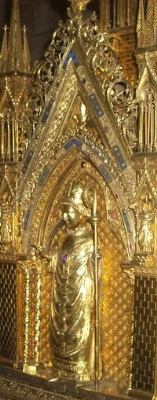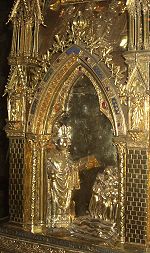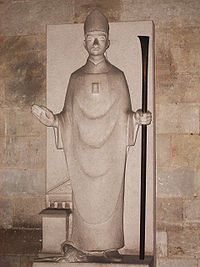
Saint Taurinus
Encyclopedia
Saint Taurinus of Évreux (died ca. 410), also known as Saint Taurin, is venerated as a saint
by the Catholic Church. His legend states that he was the first bishop of Évreux. He evangelized the region and died a martyr
.
named Deodatus, who added details according to the standard passiones of the time. The life of Saint Taurinus states that an angel
appeared to Taurinus’ mother Eustycia (Eusticie) to announce that her son would have a great destiny. His godfather
was Pope Clement I
, who entrusted Taurinus to Denis the Areopagite (mis-identified with Denis
, first bishop of Paris), who in turn was considered one of the first disciples of Saint Paul
. Thus, the legend assured that there was an "apostolic succession" from Paul directly to the episcopate of Évreux.
The garbling of dates and traditions thus ensures that it is impossible to date the time of Taurinus’ episcopacy, although scholars usually place it at the beginning of the fourth or in the middle of the fifth century.
His legend further states that Taurinus faced a demon
at Évreux that took three shapes: that of a lion
, a bear
and a buffalo
. These metamorphoses either represented various deadly sins
, or represented the official Roman religion
(lion), the worship of Diana
(bear), and the local agrarian-based religions (the buffalo).
 A number of miracles were associated with Taurinus. His legend states that he raised a girl, Euphrasia, from the dead after she died in a fire. After he had done so, there was no trace of burn marks on her. Taurinus’ miracle led to 120 converts. Taurinus is also said to have challenged the demon that resided in the statue of the goddess Diana. Having been vanquished, the demon, a small, dark, and bearded being, left the statue. Taurinus then converted the local pagan temple into a church, dedicating it to the Virgin Mary. Two priests of the goddess, Cambise and Zara, had attempted to stop Taurinus from entering the temple, but they were immobilized after the bishop made the sign of the cross
A number of miracles were associated with Taurinus. His legend states that he raised a girl, Euphrasia, from the dead after she died in a fire. After he had done so, there was no trace of burn marks on her. Taurinus’ miracle led to 120 converts. Taurinus is also said to have challenged the demon that resided in the statue of the goddess Diana. Having been vanquished, the demon, a small, dark, and bearded being, left the statue. Taurinus then converted the local pagan temple into a church, dedicating it to the Virgin Mary. Two priests of the goddess, Cambise and Zara, had attempted to stop Taurinus from entering the temple, but they were immobilized after the bishop made the sign of the cross
. They then asked to be converted to Christianity. Taurinus also brought back to life Marinus, the son of the local prefect
, who had fallen into a hole and died from the impact. After a short prayer, Taurinus revived the young man. At once, Marinus requested baptism for himself and his entourage, and 1200 other people.
After Taurinus' death, Maximus of Evreux
was sent by Pope Damasus I
to continue his predecessor's work.
 A monastery dedicated to Taurinus was built around the sixth century; it was restored in the tenth century at the instigation of Richard I of Normandy
A monastery dedicated to Taurinus was built around the sixth century; it was restored in the tenth century at the instigation of Richard I of Normandy
. Taurinus' relics were translated
to various places. In 892, Bishop Sebarius (Sébar) transferred some of his relics to Lezoux
(Puy-de-Dôme). Some of this Lezoux group of relics was later carried to the Abbey of Cluny. The remaining group was transferred to Gigny
(Jura), and their presence there is attested as of the 12th century. Other relics were deposited in the church of Pézy
before being transferred in 1024 to Chartres Cathedral.
In 1035, the abbey of Saint-Taurin was placed under the jurisdiction of the Abbey of Fécamp, which also claimed the body of Taurinus. The monks of Saint-Taurin claimed that they owned a part of the saint’s relics. In 1247, Gislebert de Saint-Martin, abbot of Saint-Taurin, had a reliquary (see gallery) built to house the remaining relics.
Saint
A saint is a holy person. In various religions, saints are people who are believed to have exceptional holiness.In Christian usage, "saint" refers to any believer who is "in Christ", and in whom Christ dwells, whether in heaven or in earth...
by the Catholic Church. His legend states that he was the first bishop of Évreux. He evangelized the region and died a martyr
Martyr
A martyr is somebody who suffers persecution and death for refusing to renounce, or accept, a belief or cause, usually religious.-Meaning:...
.
Legend
His largely legendary life is known through a manuscript of the 10th century, itself based on a ninth century text. The legendary life was written by a monkMonk
A monk is a person who practices religious asceticism, living either alone or with any number of monks, while always maintaining some degree of physical separation from those not sharing the same purpose...
named Deodatus, who added details according to the standard passiones of the time. The life of Saint Taurinus states that an angel
Angel
Angels are mythical beings often depicted as messengers of God in the Hebrew and Christian Bibles along with the Quran. The English word angel is derived from the Greek ἄγγελος, a translation of in the Hebrew Bible ; a similar term, ملائكة , is used in the Qur'an...
appeared to Taurinus’ mother Eustycia (Eusticie) to announce that her son would have a great destiny. His godfather
Godparent
A godparent, in many denominations of Christianity, is someone who sponsors a child's baptism. A male godparent is a godfather, and a female godparent is a godmother...
was Pope Clement I
Pope Clement I
Starting in the 3rd and 4th century, tradition has identified him as the Clement that Paul mentioned in Philippians as a fellow laborer in Christ.While in the mid-19th century it was customary to identify him as a freedman of Titus Flavius Clemens, who was consul with his cousin, the Emperor...
, who entrusted Taurinus to Denis the Areopagite (mis-identified with Denis
Denis
Saint Denis is a Christian martyr and saint. In the third century, he was Bishop of Paris. He was martyred in connection with the Decian persecution of Christians, shortly after A.D. 250...
, first bishop of Paris), who in turn was considered one of the first disciples of Saint Paul
Paul of Tarsus
Paul the Apostle , also known as Saul of Tarsus, is described in the Christian New Testament as one of the most influential early Christian missionaries, with the writings ascribed to him by the church forming a considerable portion of the New Testament...
. Thus, the legend assured that there was an "apostolic succession" from Paul directly to the episcopate of Évreux.
The garbling of dates and traditions thus ensures that it is impossible to date the time of Taurinus’ episcopacy, although scholars usually place it at the beginning of the fourth or in the middle of the fifth century.
His legend further states that Taurinus faced a demon
Demon
call - 1347 531 7769 for more infoIn Ancient Near Eastern religions as well as in the Abrahamic traditions, including ancient and medieval Christian demonology, a demon is considered an "unclean spirit" which may cause demonic possession, to be addressed with an act of exorcism...
at Évreux that took three shapes: that of a lion
Lion
The lion is one of the four big cats in the genus Panthera, and a member of the family Felidae. With some males exceeding 250 kg in weight, it is the second-largest living cat after the tiger...
, a bear
Bear
Bears are mammals of the family Ursidae. Bears are classified as caniforms, or doglike carnivorans, with the pinnipeds being their closest living relatives. Although there are only eight living species of bear, they are widespread, appearing in a wide variety of habitats throughout the Northern...
and a buffalo
Wisent
The wisent , Bison bonasus, also known as the European bison or European wood bison, is a species of Eurasian bison. It is the heaviest surviving land animal in Europe; a typical wisent is about long, not counting a tail of long, and tall. Weight typically can range from , with an occasional big...
. These metamorphoses either represented various deadly sins
Deadly Sins
Deadly Sins is the seventh album by heavy metal band Seven Witches.-Track listing:All tracks by Jack Frost & Alan Tecchio except were noted# "Deadly Sins" – 3:55# "Science" – 4:16# "Commence" – 4:18# "Worship" – 3:47# "Knowledge" – 3:24...
, or represented the official Roman religion
Religion in ancient Rome
Religion in ancient Rome encompassed the religious beliefs and cult practices regarded by the Romans as indigenous and central to their identity as a people, as well as the various and many cults imported from other peoples brought under Roman rule. Romans thus offered cult to innumerable deities...
(lion), the worship of Diana
Diana (mythology)
In Roman mythology, Diana was the goddess of the hunt and moon and birthing, being associated with wild animals and woodland, and having the power to talk to and control animals. She was equated with the Greek goddess Artemis, though she had an independent origin in Italy...
(bear), and the local agrarian-based religions (the buffalo).

Sign of the cross
The Sign of the Cross , or crossing oneself, is a ritual hand motion made by members of many branches of Christianity, often accompanied by spoken or mental recitation of a trinitarian formula....
. They then asked to be converted to Christianity. Taurinus also brought back to life Marinus, the son of the local prefect
Prefect
Prefect is a magisterial title of varying definition....
, who had fallen into a hole and died from the impact. After a short prayer, Taurinus revived the young man. At once, Marinus requested baptism for himself and his entourage, and 1200 other people.
After Taurinus' death, Maximus of Evreux
Maximus of Évreux
Saint Maximus of Évreux , called Saint Mauxe locally, is venerated as a saint by the Catholic Church. His legend states that he was the second bishop of Évreux, and that he died a martyr at Acquigny with his brother, who was his deacon...
was sent by Pope Damasus I
Pope Damasus I
Pope Saint Damasus I was the bishop of Rome from 366 to 384.He was born around 305, probably near the city of Idanha-a-Velha , in what is present-day Portugal, then part of the Western Roman Empire...
to continue his predecessor's work.
Veneration

Richard I of Normandy
Richard I of Normandy , also known as Richard the Fearless , was the Duke of Normandy from 942 to 996; he is considered the first to have held that title.-Birth:He was born to William I of Normandy, ruler of Normandy, and Sprota...
. Taurinus' relics were translated
Translation (relics)
In Christianity, the translation of relics is the removal of holy objects from one locality to another ; usually only the movement of the remains of the saint's body would be treated so formally, with secondary relics such as items of clothing treated with less ceremony...
to various places. In 892, Bishop Sebarius (Sébar) transferred some of his relics to Lezoux
Lezoux
Lezoux is a commune in the Puy-de-Dôme department in Auvergne in central France.-References:*...
(Puy-de-Dôme). Some of this Lezoux group of relics was later carried to the Abbey of Cluny. The remaining group was transferred to Gigny
Gigny, Jura
Gigny is a commune in the Jura department in Franche-Comté in eastern France.-References:*...
(Jura), and their presence there is attested as of the 12th century. Other relics were deposited in the church of Pézy
Pézy
Pézy is a commune in the Eure-et-Loir department in northern France.-Population:-References:*...
before being transferred in 1024 to Chartres Cathedral.
In 1035, the abbey of Saint-Taurin was placed under the jurisdiction of the Abbey of Fécamp, which also claimed the body of Taurinus. The monks of Saint-Taurin claimed that they owned a part of the saint’s relics. In 1247, Gislebert de Saint-Martin, abbot of Saint-Taurin, had a reliquary (see gallery) built to house the remaining relics.
Sources
- La Légende de saint Taurin - A.M. Baudot - 1929
- Les Saints du diocèse d'Évreux - Abbé de Bouclon
- Histoire du diocèse d'Évreux - Chanoine Bonnenfant - Paris - 1933
- Histoire et géographie du département de l'Eure - Rateau et Pinet - 1870 - Réédition 1988
- Connaissance de l'Eure - Juillet 1991 - Numéro 81 - pages 26–27 - Jacques Charles
- Connaissance de l'Eure - 1988 - Jacques Charles

